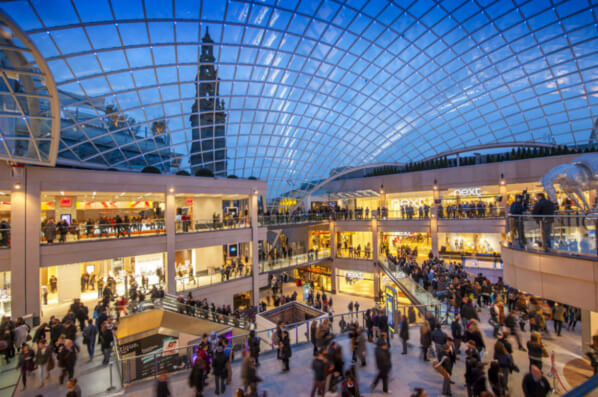In the film ‘Field of Dreams’, Kevin Costner’s character Ray Kinsella is told in his corn field that “if you build it, he will come”.
This was referring to the construction of a baseball field that will re-unite him with his late, estranged father. Following this premonition, Ray has to undergo a series of challenges in order to pull off this beyond-the-grave feat. In the face of financial ruin and the doubt of his peers, Ray ultimately succeeds to bring about Hollywood’s most epic father-and-son game of catch.
Now, it may be stretching the metaphor too far to draw meaningful parallels here. However, Land Securities seem to have had a similar proverbial whisper in the ear with regard to Trinity Leeds and, indeed, the result is if you build it, he (or in this case, they) will come. In an economic down-turn which has affected construction and retail, in particular the high street, more heavily than any other industry, there has been no shortage of obstacles to overcome here either.
Of course, the success of a building that is the first major retail development to be built outside of London since the downturn does not depend on a Hollywood-brand of supernatural interference. The key factors Trinity Leeds has put in place are: a design which considers and replicates its surroundings whilst offering a unique experience of a building; a care for the environment which includes the material used for the building, its performance in use and the preservation of the surrounding area; an experienced project team that balances skilled experts with locally employed resources; and an effective and reliable way of tying the pieces together (enter JCT design and build contract).
The ‘faith’ lies in the pragmatism of getting these things right – on time and on budget.
Trinity Leeds has been open since 21st March 2013. It cost £350m and covers an area of 1,000,000 sq ft. The building is designed in such a way that it integrates with the city landscape as a series of covered ‘streets’. Its natural light and the natural ventilation of the main mall area replicate a continuation of the high street, with the feeling of individual boutiques and boulevards, rather than one self-contained megaplex. Trinity Leeds contains around 120 shops and kiosks, which range in size from 100 to 100,000 sq ft. The outlets are represented by a mixture of high street, national and international brands, with many appearing in Leeds for the first time. Included in the development are approximately 18 restaurants, cafes and bars, and a cinema. The project itself was 95% pre-let; clearly the retailers knew that Trinity Leeds was on to a good thing.
The main contractor, Laing O’Rourke commenced site work on the 2nd August 2010. The first crane was returned on 25th September 2010 and the second crane and steelworks began in October. At the peak of the construction programme, around 600 skilled workers were on site. Laing O’Rourke’s principal responsibility as main contractor was for design and build, which included demolition and any redevelopment (although principally new-build, Trinity Leeds does include the renovation and integration of an existing 1970’s concrete-frame shopping centre). The flexibility of using the JCT design and build contract allowed Laing O’Rourke to design the construction phase from architect Chapman Taylor’s designs. The wider project team also included various engineering services, cost/project and retail delivery consultants, planning consultants, and lighting consultants (full details of the project team are listed below). In addition to these specialist roles, Land Securities also worked with the Construction Skills Academy and the Construction Youth Trust to provide employment opportunities.
The environmental consideration for this project has been substantial. Trinity Leeds has been designed to achieve BREEAM ‘excellent’. In fact, it has made a 28% improvement above Part L (CO2 emissions) of the building regulations. In the construction phase, 95% of waste was recycled. In use, the building gains efficiencies with natural ventilation and uses solar thermal energy to power the hot water supply. In addition, low water and infra-red censors are provided in the WC facilities. The building is compliant with the ISO14001 environmental management system.
Steps have also been taken to protect and enhance the natural surroundings of the building, by encouraging biodiversity with the planting of native trees and shrubs, and installing bat boxes. The building has achieved an FSC project certification and over 300 trees have been replanted in association with the Woodland Trust.
The knock-on effect of Trinity Leeds is the creation of around 3,000 retail jobs. This, as well as being good news in itself, is a boost for the area as a whole and couldn’t come at a better time. The economy of Leeds is estimated at £14.6bn and this is projected to grow by a quarter over the next decade. Market potential has already risen by 15% since Trinity opened, and with a catchment potential of 5.7m people, this has the possibility of rising further.
This has clearly been a complex project to achieve, with a lot of factors to balance successfully. This relies on the experienced client and project team that has been assembled to bring Trinity Leeds to life. The choice of the JCT design and build contract once again provides a form that can be relied upon and allows each discipline to come together and successfully deliver.
With its effort to engage the surroundings, offer a natural and integrated experience, be environmentally considerate and provide opportunities for so many, Trinity Leeds has gone way beyond your average run-of-the-mill shopping centre. You might even say it’s transcendent.

